Eugene Tan turned his love of photography and the ocean into a job that most photographers would kill for. He talks to Marc Gafen about his brilliant career and his approach to photography.
You might not have heard the name Eugene Tan, but if you love landscape photography, and specifically surf photography and seascapes, you most certainly would be familiar with the company he formed back in 1999, Aquabumps. Eugene Tan, also know as ‘Uge’, might be just a man, but the company he created is a brand known to literally hundreds of thousands of people around the globe.
It’s no wonder he’s considered one of Australia’s most successful surf photographers. Every day, over 51,000 people receive an e-mail update from Aquabumps, while the organisation’s Facebook page boasts almost 82,000 fans – a 100% growth in the last two years. The website is equally popular, attracting roughly 180,000 unique visits each month. And since Aquabumps opened its first gallery in 2004, Tan has sold almost 25,000 coastal and surfing photographs.
An early start
Growing up in Western Australia, Eugene Tan got his first taste of surfing at age three, clinging to his father’s back when he body surfed. He got an early start in the visual world too, first picking up a camera at the age of nine. Fascinated with the world around him, he used to take his camera everywhere and document everything around him – his school yard, his home, his mates, and pretty much anything that caught his eye. But professional photography wasn’t the first career that caught his attention.
Although he did study photography as part of a design degree, Tan worked in the corporate world for 10 years as a creative director for a digital agency. During that time, he found he sought an additional outlet for his creativity, not one driven by client requirements and formal briefs. And for Tan, that outlet turned out to be photography. This sideline hobby turned into a full-blown passion, and for the last five years of his corporate career, Tan was sowing the seeds for his next career, as a professional photographer. Working nine to five, five days a week, he would wake before sunrise each day and head down to Bondi beach to shoot photographs.
In 1999 Tan started his now famous blog, Aquabumps. “It was really just an e-mail to mates,” he says, “before blogs were the buzz word of the day and before the digital space really bloomed.” But the notion to leave the comfort and security of a full-time job to start up his own business in a category that didn’t really exist at the time was not a decision Tan made without serious consideration. As the interest in his work grew and Tan started making more print sales, the notion grew less outlandish and more realistic. Nonetheless, he recalls that the decision was incredibly difficult, as was earning next to nothing when he first started.
With a growing following, Tan came across a small retail space in North Bondi where he could show and sell his work. Signing the lease for the property was a pivotal moment, with Tan thinking “it’s now or never”. Sick of “working for man”, as Tan put it, he made the move because he wanted run his own business and not be accountable to anyone else. “I wanted to work and live and combine my love of the beach to make a living, with no more trips into the city.”
Entirely self-taught, and without having assisted other professional photographers, Tan developed and honed his skills through reading, research and taking a lot of pictures which he would then critically assess as a way to improve. Any time he was faced with an obstacle he couldn’t overcome, he’d consult with photographers he respected and admired. You’d never know it by looking at his work, but after 13 years of shooting professionally, Tan believes he still has a long way to go and that his best is yet to come. “I’m still learning,’ he says, “And I hope to continue to get better as I shoot and grow as a photographer.”
In 1998, Surfing World magazine facilitated a trip to Samoa for Tan, who went along as the online blogger, while Jon Frank, considered by many to be one of the best surf photographers in the business, took photos. Tan says that travel experience was to have a massive impact on him, and his passion for surf and ocean photography grew immensely afterwards. Frank became something of a mentor to Tan and it helped confirm in his own mind that it was the category he wanted to base his business around.
'Jade Green,' Bondi, 2013. Canon EOS 5D Mk II, TS-E 90mm f/2.8, 1/1600s @ f/5, ISO 100. Shot from a helicopter.
Early days
The first few years of any new business come with their fair share or challenges, and Tan’s experience was no different. The gallery space was the first step in starting to make an income from the fledgling business, but at the outset it wasn’t quite enough. Supplementing his initial income with commissioned freelance work, he shot editorial assignments for a number of titles including Madison and Australian Traveller Magazine, as well as travel features. He was also commissioned by surfers to shoot them while on they were on surfing trips to the Mentawi Islands in Indonesia.
Tan is proof that if you do something with discipline, conviction, passion and drive, and you do it every single day, you’re bound to be successful. At one stage, while working in the corporate world, he had 16 designers producing material for him. And what he’s done with his photography is turn Aquabumps from “a little tiny blog on the side, trickling away” into something of a phenomenon with sponsors of the brand including HTC, Peroni, Telstra, Canon and Land Rover.
Some of the photographers with whom Tan credits as having an influence on him as he was building his career include Jon Frank, Christian Fletcher, Richard Misrach, Max Dupain and Rod Owen. Of these, Jon Frank is the one that he’s turned to time and time again for inspiration and guidance.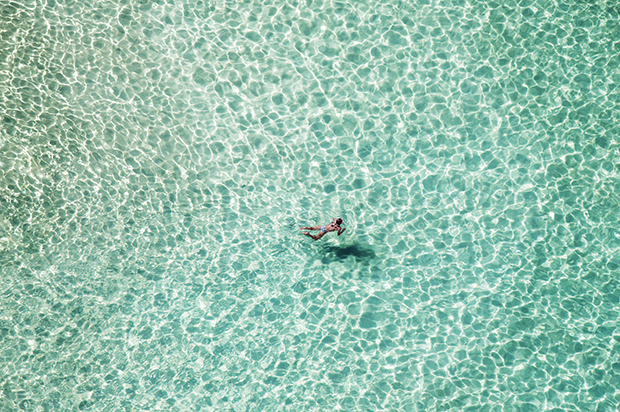
‘Lone swimmer,' Bondi, 2009. Canon EOS 1D Mk III, 300mm lens and 2x converter, 1/320s @ f/9, ISO 500. Shot from a helicopter.
Occupational hazards
Many of Tan’s images are taken in the water, and this comes with some risks, particularly at some of the bigger breaks. One of his close calls came at ‘Ours’, a treacherous surf break off Kurnell in Sydney, where he he split his head open on rocks. One website describes the conditions at Ours as for ‘pros or kamikazes only’.
“I think my wife often wonders if I’ll come back in one piece from shooting Pipeline most days when we’re in Hawaii,” Tan says.
Even the pristine waters of Bondi have their fair share of concerning elements. Tan tells of one instance where he was chased out of the water by a stingray, which he says was as big as a car bonnet, and “pretty scary”!
Aside from all the obvious dangers which come from working in the ocean, there’s also all those very early morning starts which are likely to turn all but the most passionate off even considering following in Tan’s footsteps.
“I love getting up before sunrise,” Tan says. “It’s only on the days that are on-shore and raining that I find it hard. Most people probably think that I swan around not doing much at all, but that couldn’t be further from the truth.”
While a significant proportion of the work he generates and produces is shot on Bondi Beach, Tan travels to a number of idyllic locations around the world on a regular basis. Some of his favourite spots include Fiji, Hawaii and Bali.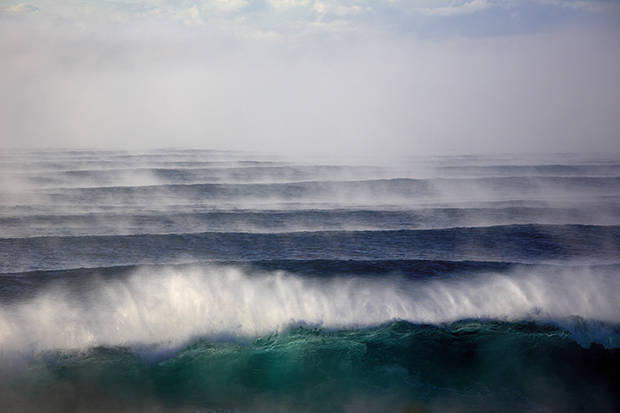
'Corduroy Steamers,' Maroubra, NSW, 2012. Canon EOS 5D Mk III, Canon EOS 5D Mark III, EF 70-200mm f/2.8L IS USM lens, 1/800s @ f/9, ISO 320.
Paying the bills
These days, Tan derives most of his income via print sales from his gallery showroom. The offerings, however, are also available online through the Aquabumps website. Ranging from $150 to just under $3,000 per image, there’s literally something for every budget.
In a particularly envious predicament, Tan splits his time disproportionately between commissioned and non-commissioned work. “I spend around 95% of the time doing what I truly love – roaming the beaches, stalking waves and good light. The remaining five percent is spent on commissions, and they are usually based around my specialities of underwater and aerial photography.”
Equally enviable is the fact that he’s so busy doing what he does that he doesn’t actually have to chase commissions.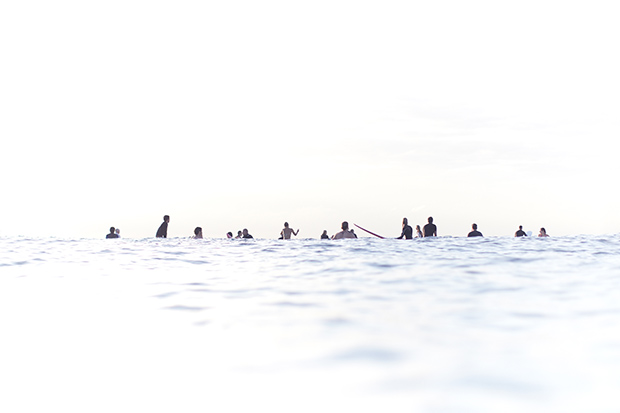
'The White Line Up,' Bondi, 2013. Canon EOS 1D Mk IV, 50mm lens, 1/8000s @ f/1.8, ISO 320. Aquatech housing.
Image style
Tan describes himself as a ‘reportage’ photographer. His whole approach to photography is based around documenting what he sees, be it underwater or above the beach in a helicopter. “My style is voyeuristic,” Tan says, “capturing beautiful light and capitalising on sunrise and sunsets. You can have all the best gear and experience in the world, but I guess my point of difference is that I am purely focused on one single topic – the beach, and I put all my efforts into the subject.” His approach has clearly paid off, and his signature style is obvious.
The process Tan followed to develop his style is interesting. “I used to just sit on the rocks and observe my surroundings,” he says. “And I’ve never been afraid to try new things.” Over the last few years, more and more aerial images are now available for sale. “I spent a lot on chopper rides before I started nailing it, and I can assure you it was a very expensive exercise,” he says.
Asked which images best reflect his photographic style and which can comfortably be considered the Aquabumps signature images, Tan says that this is reflected in much of his aerial and ‘under the wave’ images; essentially everything he loves about beach life, but shot in an unobtrusive way. His website gathers his favourite images together on a special page.
The advice Tan offers anyone wanting to develop a signature style of their own is to always make it about a subject you love. By doing this, he says, you’re unlikely to tire of it, because you’re going to have to shoot it as much as possible. Another way to stand out is to try and focus on shooting something which hasn’t been shot much before. In an age where everyone carries a camera all the time, this is becoming much more challenging!
North Bondi Boat Ramp, NSW. Canon EOS 5D Mk III, 17-40mm lens @ 25mm, 1/800s @ f/4, ISO 1600. Taken from RC drone.
Equipment & lenses
Tan has been using Canon gear from his early days, and while he does rely on a number of different cameras, his main workhorse is the Canon EOS 1D X. His kit also includes the Canon EOS 5D Mk III, a 5D Mark II and an EOS 1D Mark IV. He owns almost the entire range of Canon L-series lenes from the 14mm f/2.8 all the way up to a 400mm f/2.8.
To help get closer to the action, he relies on Canon’s 1.4x and 2x extenders while his favourite lens is the 50mm f/1.2. “I use it every day, no matter what,” Tan says. And I love the bokeh.” Other essential items in his kit include a Manfrotto carbon-fibre tripod, a ThinkTank Airport International V2.0 backpack, Pelican cases and Aquatech underwater housing.
With all the time Tan spends in the water, and the risks of losing gear, he’s been rather fortunate in having lost only two rigs so far – one in an underwater housing which sank to the bottom of the ocean, and another flying remote controlled, which crashed into the sea!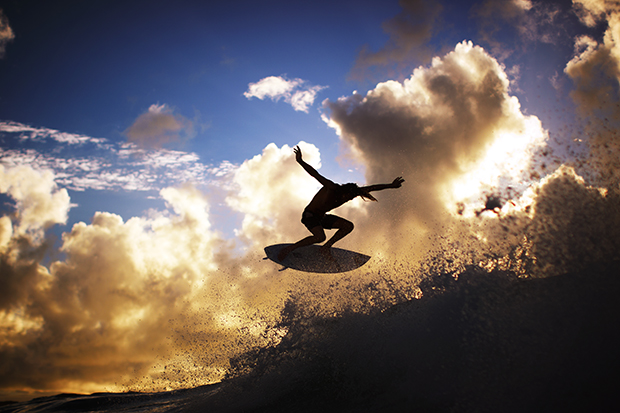
'Free as a bird', Bondi, NSW. Canon EOS 1D MK IV, EF 50mm f/1.2 USM lens, 1/6400s @ f/1.8, ISO 50. Aquatech underwater housing.
Tips & advice
For anyone considering a career in photography, Tan’s advice is forthright. “Don’t have fear. Don’t be scared to do something different”, he says. “If you can’t imagine yourself doing anything else other than photography, then you owe it to yourself
to pursue it.”
But with all the other photographers out there, you’ll want to watch, learn and shoot as much as possible. Tan believes the more time you spend with your camera, the better.
Asked for three pearls of wisdom to help others shoot better photos, Tan proffers the following: get the right camera gear and invest in good quality lenses, shoot at every opportunity (ideally every day) and finally, when you think you can’t shoot any more, then shoot some more!
From a humble beginning in a small gallery space in North Bondi, in 2004, Tan has grown his business immensely. In 2008, the company relocated to downtown Bondi and opened a significantly larger 186 square metre gallery. “This is the pursuit of a passion,” he says.
Now with his own line of Speedo swimwear, featuring his images, Tan still has a number of new and exciting challenges on the horizon. There’s the task of renovating the Aquabumps gallery to make it larger, but he’d also like to make it more of a destination, a creative hub for people to visit.
Another large project to be completed later this year will be his second book, Aquabumps Beach Blog. Making a career out of passion still comes with its fair share of drawbacks. With the gallery open seven days a week, and Tan still shooting every day, he says he never really gets to switch off, and there’s not a great deal of down time.
"Some days I feel like I get pulled in a million directions, and yeah, it’s hard, but would I swap it for my old life? Never!”
See more Eugene Tan images at www.aquabumps.com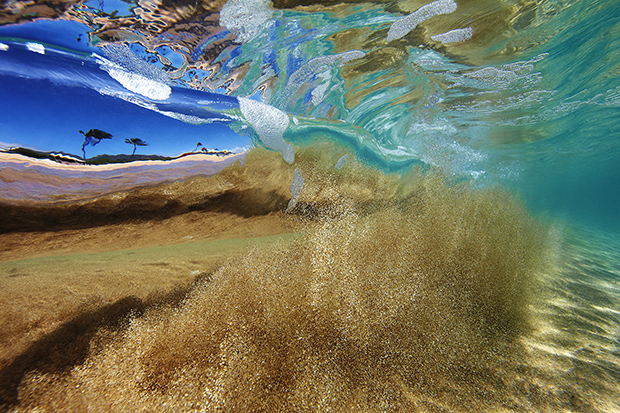
'Shorey Glory 1,' Hawaii, 2010. Canon EOS 1D Mk IV, 14mm f/2.8 lens, 1/2000s @ f/8, ISO 500. Aquatech housing.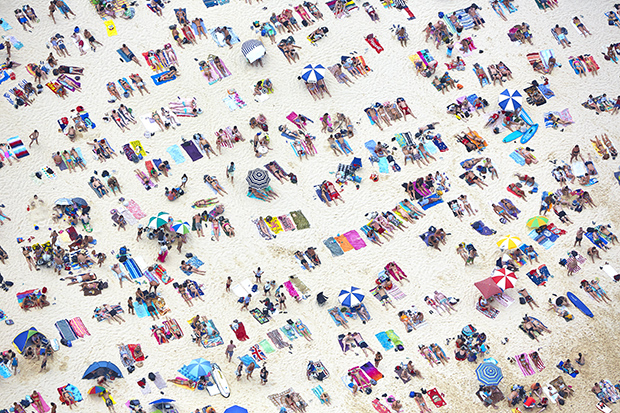
'The colours of Bondi,' 2013. Canon EOS 5D Mk III, 70-200mm f/2.8L IS USM lens, 1/1600s @ f/5, ISO 500. Image shot from a helicopter.
Jamie O’Brien, Pipeline, Hawaii. Canon EOS 1D Mk IV, EF 50mm lens, 1/800s @ f/13, ISO 400. Aquatech underwater housing.














